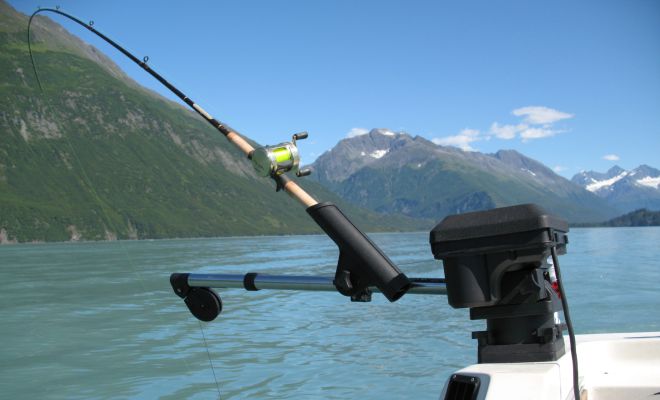 By Marcus Weiner
By Marcus Weiner
My favorite way to troll for salmon in saltwater is to employ a downrigger. It allows for precision placement of whatever bait or lure (collectively termed baits) you use to attract salmon. Combined with a quality fish finder, it allows anglers to get dialed into where the salmon are located in the water column and place the baits just above them. It makes it easy to repeatedly place baits at the same depth, or to accurately change depths as needed. With a downrigger near the stern on both the port and starboard sides of the boat, anglers can fish two lines or stack two lines per downrigger and fish four lines. Double the amount of downriggers and you double the amount of lines that can be fished simultaneously.
Downrigger Components
Downriggers are easy to use and straightforward in design. A spool holds a long length of downrigger cable, let’s say 600 feet – which until recently, was mostly stainless-steel wire (with the proliferation of super lines on the market today, heavy super line is often used instead of wire for cable). The cable originates on the spool and runs the length of the boom (typically these are two- to five feet long) which has a pulley on the end. The cable runs over the pulley and attached to the end of the cable is the downrigger weight. Weights come in a range of shapes (cannonball, disc, fish shaped) and sizes (5- to 15 pounds) with the standard being a 10-pound cannonball. Attached to the cable either to the weight or not far from the weight is the downrigger clip. That’s where you attach your fishing line when it’s time to deploy the bait or lure. The downrigger mount is attached to your boat and couples with the downrigger allowing you to remove the downrigger when not in use.
Styles of Downriggers
Downriggers come in both manual- and electric models. The two different types have their pros and cons. The manual downriggers are more portable and you don’t need power. They are also less expensive. The downside is that you have to use muscle-power to raise them—which can be a bit of a chore while trying to fill a six-fish limit of silvers for several anglers. There are several good brands of downriggers on the market. Scotty, among others, makes good ones.
Electric downriggers require a power source, wiring, cost more and have more parts – which can mean more repairs, but don’t require muscle-power to raise them. That makes it easier on the angler and since the downrigger retrieves the weight with a flip of a switch, that angler is now free to retrieve lines. It also allows the angler to more quickly and easily get the downrigger weight out of the way when fighting a fish, especially when fishing without another person on the deck with you.
Other considerations include getting a downrigger with a big-enough boom to keep your lines clear of the boat during turns, having a spot to mount your downriggers so that you can reach the downrigger clip to attach lines, and having adequate storage space to stow downriggers when not being used.
How-to Use Downriggers: Basics
Attach your downrigger to the downrigger bracket and position the boom so it points perpendicular to the port or starboard side of the boat. Attach the downrigger weight to the end of the cable and place in the water. Attach the downrigger clip to the cable or weight.
Put the boat in gear, to create forward motion which will reduce tangles. Using whatever setup you choose on your rod – we’ll address this more later – let out 5- to 25 feet of line. Attach the line to the downrigger clip. Free spool the reel but keep your thumb on the spool and slowly lower the downrigger weight to the desired depth while making sure your reel doesn’t backlash. Depending on the size and style of downrigger weight that you use, as well as the speed at which you troll, the downrigger cable extends at an angle into water (rather than straight up and down). This is called blowback. With experience, you’ll learn how much extra cable to let out to get to the precise depth that you want. One way to determine the amount of blowback is to move at trolling speed and drop the weight until it hits the bottom at a known depth. Look at the depth your downrigger says and compare that to the actual depth to determine the blowback ratio. Another method is to look at your fish finder. It will often mark your downrigger balls if they are still within the cone of the fish finder.
Engage the reel. Place the rod in the rod holder and slowly remove the slack in the line until it’s gone and the rod is under tension in a parabolic arc. When a salmon strikes the bait and becomes hooked, it will usually pop the line free of the clip. The bent rod acts to minimize any slack caused by the strike when it straightens out. With practice you learn where on the downrigger clip to set the line so that there’s enough tension to allow you to load the rod and remove slack without it popping out of the clip, but not so deep into the clip that a salmon can’t easily pop it out of the clip, or worse yet, break the line when striking or when an angler manually pops the line out of the clip.
Now you are ready to troll at your desired speed. We’ve noticed over time that many strikes occur when the boat is making a turn. When the boat turns, the inside line slows down while the outside speeds up. This erratic motion seems to provoke salmon to strike. Strikes can happen anytime, but keep a watchful eye when the boat turns.
The general consensus is to troll with the tide, but wind, tide strength and the vagaries of the day should be considered. Another generally accepted truth is that fishing is often best about two hours before through two hours after a tide change.
Downrigger Tackle
There are many types of baits that can be used to attract salmon. Perhaps the most popular is herring. Herring can be rigged whole or plug cut, and there are many variations in how anglers rig herring. The common belief is that Chinook like a slower, wider spin, while coho like a fast, tight spin. Whole herring are rigged with a bend to produce this spin while plug cut are cut at a compound angle to produce the desired spin. We recommend brining your baits as they will last longer and look better. Scent can also be added and Pro-Cure makes a wide variety of proven scents.
Other highly popular baits include hoochies, baits to replicate plug cut herring like Brad’s Super Bait Cut Plug or original Super Bait, trolling spoons like the Silver Horde Coho Killer and Kingfisher or Luhr Jensen Coyote, and flies like the Silver Horde Ace Hi Fly. UV and Glow are the best color options, especially when fishing at depths below 60 feet. Adding scent will only help.
Almost universally, anglers will position a flasher ahead of the bait to create flash, vibration and give action to the bait. Popular flasher manufacturers include companies like Hot Spot, Pro-Troll, and Short Bus Flashers. There are endless colors of flashers on the market these days; personal preference and conditions come heavily into play.
Rods should have a soft tip and solid butt section. They need to be soft enough to allow a salmon to grab the bait and turn without feeling too much resistance. But they need to be strong enough in the bottom half to allow an angler to control 10- to 40 pounds of thrashing chrome fury, often with obstacles like other angler’s lines, downrigger cables, and outboard motors to navigate around. The great majority of fishermen use baitcasting-style rods; we prefer rods that are 7- to 9 feet long and with a rating of 10- to 25-pound-test. Cousins and Okuma make good ones, though many manufacturers make suitable rods.
Reels should have a strong, smooth drag, and be able to hold at least a couple hundred yards of 50-pound-test braid. The reel will bear the brunt of the abuse when salmon fishing, so buy the best you can afford.
We use braid as our mainline, and 50-pound-test P-line XTCB braid is a good choice. We attach a 50-foot top shot of P-Line Tactical Fluorocarbon to the braid. That allows for a stealthy presentation and provides just a little stretch which reduces pulled hooks.
Leader material and pound-test are personal choices. I use 20- to 40-pound P-Line Tactical Fluorocarbon. Seaguar STS Salmon Fluorocarbon is another great one. My typical leader length from flasher to bait is usually 2- to 4-feet. You are looking for the flasher to impart action to the bait and the shorter or stiffer the leader, the more action will be imparted to your lure. Put the gear in the water and motor at trolling speed and see what the action looks like. Adjust as needed to get adequate action but not so much that it becomes excessively erratic.
Finding Salmon
Kings tend to reside lower in the water column, often at least 60 feet down and usually closer to the bottom than the surface. Coho tend to be in the upper part of the water column, let’s say the top 80 feet. Since both are chasing bait in the saltwater they relate to structure that holds bait like points, shelves, sudden drops, pinnacles, kelp beds and the like. It’s also important to realize that certain spots troll better depending if it’s an incoming or outgoing tide.
Look for rip lines, current seams, freshwater inlets, and past known successful spots. One of the benefits of trolling is that you can cover a lot of water and while you are moving to find fish, you are still fishing.
Marcus Weiner is Publisher of Fish Alaska and Hunt Alaska magazines.


